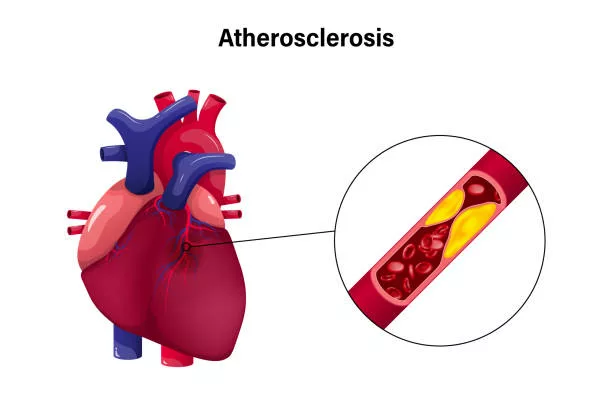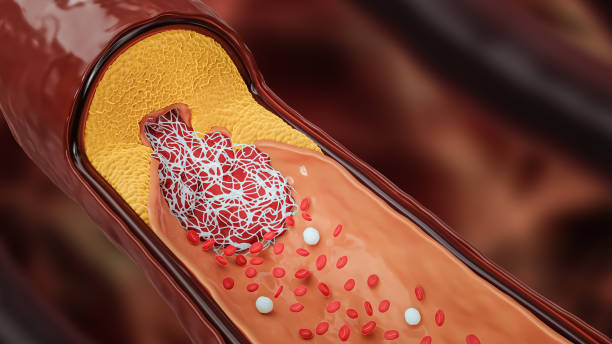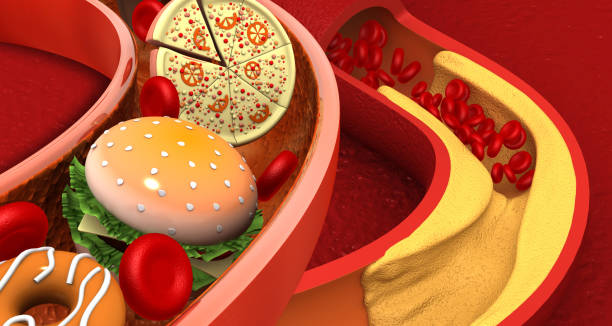Atherosclerosis is a disease of the large and intermediate-sized arteries in which fatty lesions called plaques develop on the inside of the arterial walls of the aorta – hence the name aortic atherosclerosis. The blood vessel generally becomes thickened and stiffened. The lack of distensibility and flexibility in atherosclerosis arteries makes them more susceptible to rupturing. However, early detection can prevent and cure this disease.
What is Aortic Atherosclerosis?
Generally described, Aorta is the major vessel of the heart and gives off many smaller branches to carry oxygen-enriched blood to all other body parts, including the brain, kidney, and other vital organs. If the pathway gets disrupted for any reason, it can affect any other body part.
are atheromas, atherosclerotic debris, protruding atheromas, and plaque. They are considered a potential source of mobile plaque called an embolus.
Atheroma Formation
Inside the artery, the fatty streaks grow larger with time and fuse, causing the plaque deposits to grow larger and larger such that it bulges into the lumen of the artery (the space where blood flows inside the vessel) and blocks the vessel. This plaque is called an atheroma.
Atheroma reduces the blood flow to other organs- causing ischemia (lack of oxygen) to organs and tissues. No oxygen to tissues results in abnormal functioning, leading to numerous diseases, and can cause tissue death if the ischemia continues for longer.
Symptoms of Aortic Atherosclerosis
If you experience any of the following symptoms, it is crucial to seek medical attention immediately, as it may indicate a medical emergency.
- Chest Pain
- Shortness of breath (Dyspnea)
- Heart Palpitations (Fast heart rate)
- Vomiting or Feel to Vomit ( Nausea)
- Discomfort in your left arm, shoulder, neck, or back
- Dizziness, lightheadedness
- Fatigue
These are the most common symptoms. Below are the less common symptoms that also indicate an alarming situation.
- Abdominal pain
- Excessive sweating
- Cold extremities ( hands and foot)
How this Vulnerable Plaque Actually Develops in Your Body?
Atherosclerosis is the thickening of arteries and vessels, ultimately lowering the oxygen supply to organs. This thickening causes narrowing and stiffness of the main course of blood and nutrient supply. Hence, the compromise of blood, oxygen, and nutrient supply results in the deterioration of the internal organs.
Atherosclerotic Calcification:
When the plaque composed of fats and cholesterol stays for long in arteries, it develops calcification (simply solidifies with deposition of calcium) in it. Atherosclerotic calcification causes stenosis. These plaques are most stable than non-calcified plaques. 1“Calcification in atherosclerosis | Nature Reviews Cardiology” https://www.nature.com/articles/nrcardio.2009.165

Atherosclerotic Calcification of Aorta:
Atherosclerotic calcification of the Aorta2Thomas, I. C., Thompson, C. A., Yang, M., Allison, M. A., Forbang, N. I., Michos, E. D., McClelland, R. L., Budoff, M. J., & Criqui, M. H. (2018). Thoracic aorta calcification and noncardiovascular disease–related mortality: The Multi-Ethnic Study of Atherosclerosis. Arteriosclerosis, Thrombosis, and Vascular Biology, 38, 1926-1932. https://doi.org/10.1161/ATVBAHA.118.310850 develops gradually over the years. A patient may remain asymptomatic for years and experience sudden emergencies any night. It is a silent killer for a patient with a chronic history of high blood pressure or stroke or who suffered angina previously.
Effects of Calcification of Atheroma:
Intravascular imaging technology helps early detection of calcified atheromas. According to Maggie et al. (2013)3Shi X, Gao J, Lv Q, Cai H, Wang F, Ye R, Liu X. Calcification in Atherosclerotic Plaque Vulnerability: Friend or Foe? Front Physiol. 2020 Feb 5;11:56. doi: 10.3389/fphys.2020.00056. PMID: 32116766; PMCID: PMC7013039.. Greater the calcification of atheroma, the greater the incidence of stroke and heart attack in patients.
Thus, atherosclerotic calcification is directly proportional to vulnerability. Usually, the most affected vessel is the largest artery, Aorta.
Calcified atherosclerosis of the Aorta leads to two kinds of emboli.
- Thromboemboli: Large, occlude medium to large arteries. They may cause strokes, transient ischemic attacks, renal infarcts, and peripheral thromboembolism.
- Atheroemboli are minute. Tend to occlude small arteries and arterioles and may cause blue toe syndrome, new or worsening renal insufficiency, gut ischemia, etc.

How Serious is Aortic Atherosclerosis of the Aorta?
The condition can be fatal or life-threatening. Abnormalities in Aorta can lead to several complications. A few are mentioned below:
- Cerebral Atherosclerosis is when it reaches the brain and blocks cerebral arteries.
- Reduction in blood flow to your large intestine causing Acute ischemic colitis.
- Compromised arterial flow to kidneys causing Renal Infarction.
- Splenic infarction is a reported complication.
- Aortic arch diseases such as narrowing or weakening lead to reduced blood flow or the formation of abnormal balloon-like bulges called aneurysms in the arterial wall.
They are life-threatening if left untreated. Atherosclerosis is another common cause of aortic arch disease.
Is Aortic Atherosclerosis Common?
Almost half of all the deaths4Pahwa R, Jialal I. Atherosclerosis. [Updated 2022 Aug 8]. In: StatPearls [Internet]. Treasure Island (FL): StatPearls Publishing; 2023 Jan-. Available from: https://www.ncbi.nlm.nih.gov/books/NBK507799/ in the United States and Europe due to vascular disease. One must know that Aorta is the major vessel of the heart supplying the blood to other body organs. About 2/3 of the deaths are caused by blockage of one or more coronary arteries, and the remaining 1/3 are caused by vessels in other body organs, especially the brain. { Pahwa R, Jialal I. Atherosclerosis. [Updated 2022 Aug 8]. In: StatPearls [Internet]. Treasure Island (FL): StatPearls Publishing; 2022 Jan-. Available from: https://www.ncbi.nlm.nih.gov/books/NBK507799/
Who are at Risk?
Men are more likely to develop atherosclerosis than women. But people with the following conditions are the most prone to it.
- Low physical activity
- Obesity
- Diabetes mellitus
- Hypertension
- Hyperlipidaemia
- Cigarette smoking
- Alcohol
- Social deprivation
When hypertension and diabetes mellitus are present, the risk for atherosclerotic coronary artery disease is increased by more than eightfold. And if hyperlipidemia is also present, the risk is increased by 20-fold.
Another important factor is the rise in bad cholesterol in the body, i.e., the rise in LDL levels. Its high concentration in the body causes a high chance of developing an atheroma in the artery or any other vessel.
Is it a Preventable Disease?
Yes. It is a presentable disease, and you can save yourself from developing this condition with a very simple lifestyle change.
It is the intake of a balanced diet. You heard it right. A balanced diet along with moderate physical activity is the key solution. It prevents the accumulation of bad cholesterol in the body, and a high amount of antioxidants keeps the body free of inflammation and the production of plaque in the vessels.
A balanced diet comprising bran, oats, and adequate water will automatically result in optimum blood glucose levels and blood pressure. So you won’t have diabetes and hypertension as well. A balanced diet is one step toward a healthy life and an ideal weight.
Smoking is one of the most common causes of atherosclerosis, so avoid that too.
How to Diagnose?
Complete history, physical examination, and diagnostic tests combine to make a definite diagnosis. So, the patient should be open to his physician in providing his personal history.
The most important diagnostic tests that determine the extent of the atheroma formation, i.e., plaque buildup in arteries, are:
- CT scan (Computed tomography )
- MRI (Magnetic resonance imaging )
- Transesophageal echocardiogram
Treatment Options:
It is a serious and potentially life-threatening condition that can lead to aortic aneurysm and rupture. It is important to know the associated risk factors, including age, family history, smoking, high cholesterol, and hypertension.
1- Get a Proper Treatment Plan from Your Healthcare Provider
Once you are facing blockage in your aorta, generally, it’s normal to stay there. But improvement can occur with medication and better lifestyles. It can lead to slowing or stopping plaque progression. Atheromas might even shrink with aggressive and invasive treatments.
2- Lifestyle Changes

Lifestyle modifications such as smoking cessation, healthy eating, and regular exercise are important for reducing risk factors associated with aortic atherosclerosis, especially heart attacks and strokes.
3- Medication
Drugs against high cholesterol and high blood pressure, such as antihypertensive and antihyperlipidemic drugs. They help in lowering the risks of heart attacks and strokes.5Impact of lipid lowering on coronary atherosclerosis moving from the lumen to the artery wall – Atherosclerosis” https://www.atherosclerosis-journal.com/article/S0021-9150(23)00029-1/fulltext
Medications such as statins, beta-blockers, and ACE inhibitors help reduce cholesterol and lower blood pressure, which can significantly reduce the risk of aortic aneurysm and rupture.
Early diagnosis and treatment of this condition are critical to ensure a positive outcome. Treatment options for aortic atherosclerosis include lifestyle modifications, medications, and surgery. Surgery is sometimes necessary to repair an aortic aneurysm or remove plaque buildup.
Last but not Least
Aortic atherosclerosis is a serious condition that can lead to complications and damage to vital organs. Early diagnosis and treatment are essential for reducing risk factors and improving patient outcomes. Lifestyle modifications and medications are some of the available treatment options. By reducing risk factors and following recommended treatments, patients can reduce their risk of complications and improve their overall health.
Refrences
- 1“Calcification in atherosclerosis | Nature Reviews Cardiology” https://www.nature.com/articles/nrcardio.2009.165
- 2Thomas, I. C., Thompson, C. A., Yang, M., Allison, M. A., Forbang, N. I., Michos, E. D., McClelland, R. L., Budoff, M. J., & Criqui, M. H. (2018). Thoracic aorta calcification and noncardiovascular disease–related mortality: The Multi-Ethnic Study of Atherosclerosis. Arteriosclerosis, Thrombosis, and Vascular Biology, 38, 1926-1932. https://doi.org/10.1161/ATVBAHA.118.310850
- 3Shi X, Gao J, Lv Q, Cai H, Wang F, Ye R, Liu X. Calcification in Atherosclerotic Plaque Vulnerability: Friend or Foe? Front Physiol. 2020 Feb 5;11:56. doi: 10.3389/fphys.2020.00056. PMID: 32116766; PMCID: PMC7013039.
- 4Pahwa R, Jialal I. Atherosclerosis. [Updated 2022 Aug 8]. In: StatPearls [Internet]. Treasure Island (FL): StatPearls Publishing; 2023 Jan-. Available from: https://www.ncbi.nlm.nih.gov/books/NBK507799/
- 5Impact of lipid lowering on coronary atherosclerosis moving from the lumen to the artery wall – Atherosclerosis” https://www.atherosclerosis-journal.com/article/S0021-9150(23)00029-1/fulltext

